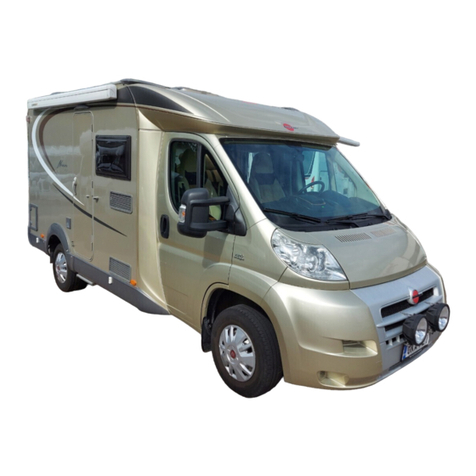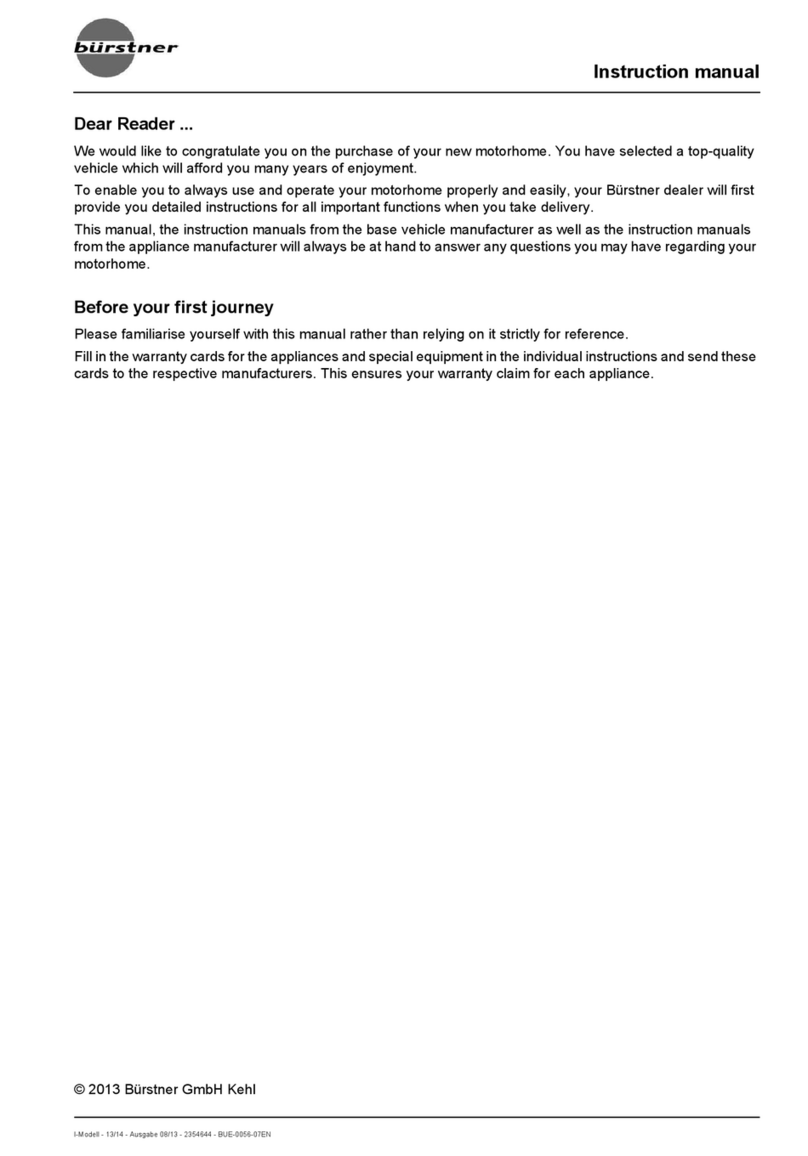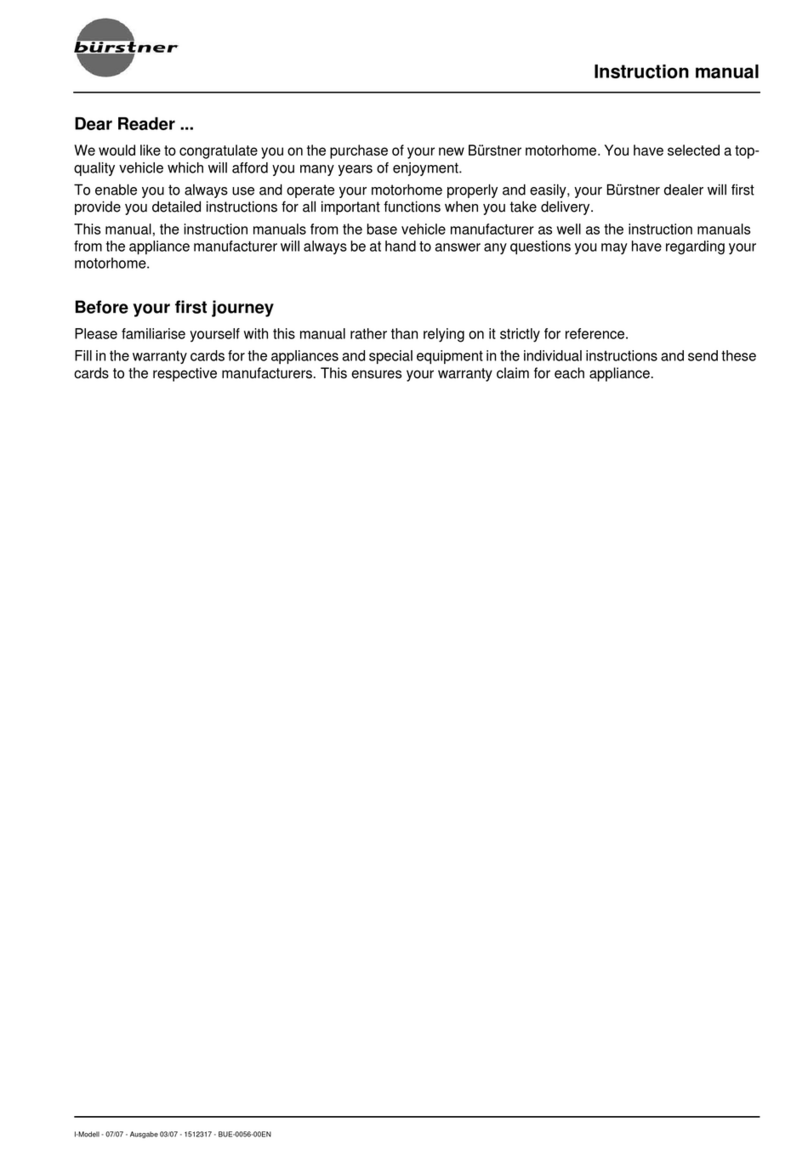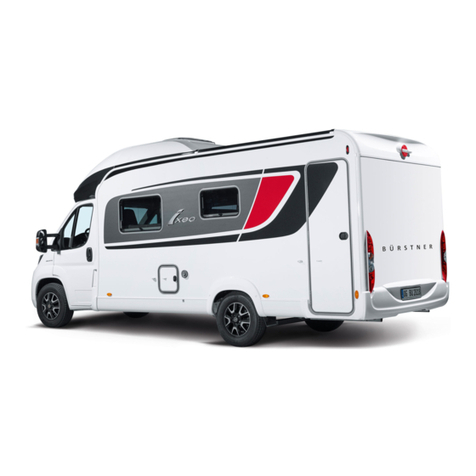
T-Modell - 04/05 - Ausgabe 08/04 - 201804286 - BUE-0006-04EN 5
Contents
9.5.2 Refrigerator (Model RM 7361
and RM 7401) . . . . . . . . . . . . . . . 128
9.5.3 Refrigerator
(Model RM 7655). . . . . . . . . . . . . 130
9.5.4 Refrigerator Door Locking
Mechanism . . . . . . . . . . . . . . . . . 132
10 Sanitary Fittings . . . . . . . . . . . . 135
10.1 Water Supply, General . . . . . . . . 135
10.2 Water Tank . . . . . . . . . . . . . . . . . 135
10.2.1 Volumes. . . . . . . . . . . . . . . . . . . . 135
10.2.2 Fresh Water Filler Neck. . . . . . . . 136
10.2.3 Filling with Water. . . . . . . . . . . . . 136
10.2.4 Draining Water. . . . . . . . . . . . . . . 136
10.3 Filling the Water System . . . . . . . 137
10.4 Emptying the Water System . . . . 138
10.5 Waste Water Tank. . . . . . . . . . . . 139
10.5.1 All Models Except Delfin
Performance . . . . . . . . . . . . . . . . 139
10.5.2 Delfin Performance . . . . . . . . . . . 140
10.6 Waste Water Tank Heater
(Special Equipment) . . . . . . . . . . 141
10.7 Toilet Compartment. . . . . . . . . . . 141
10.8 Toilet (Thetford Toilet) . . . . . . . . . 141
10.8.1 Swivel Toilet . . . . . . . . . . . . . . . . 142
10.8.2 Toilet with Fixed Seat . . . . . . . . . 147
11 Care. . . . . . . . . . . . . . . . . . . . . . . 153
11.1 External Care. . . . . . . . . . . . . . . . 153
11.1.1 Washing with a High-Pressure
Cleaner . . . . . . . . . . . . . . . . . . . . 153
11.1.2 Windows of Acrylic Glass . . . . . . 154
11.1.3 Washing the Motorhome . . . . . . . 154
11.1.4 Underbody. . . . . . . . . . . . . . . . . . 154
11.1.5 Waste Water Tank. . . . . . . . . . . . 155
11.1.6 Entrance Step . . . . . . . . . . . . . . . 155
11.2 Caring for the Interior. . . . . . . . . . 155
11.3 Winter Care . . . . . . . . . . . . . . . . . 156
11.3.1 Preparations . . . . . . . . . . . . . . . . 156
11.3.2 Winter Operation . . . . . . . . . . . . . 156
11.3.3 At the End of the Winter
Season . . . . . . . . . . . . . . . . . . . . 156
11.4 Lay-Up. . . . . . . . . . . . . . . . . . . . . 157
11.4.1 Temporary Lay-Up. . . . . . . . . . . . 157
11.4.2 Winter Lay-Up . . . . . . . . . . . . . . . 158
11.4.3 Starting Up the Vehicle after
a Temporary Lay-Up or after
Lay-Up over Winter . . . . . . . . . . . 159
12 Maintenance. . . . . . . . . . . . . . . . 161
12.1 Inspection Work. . . . . . . . . . . . . . 161
12.2 Maintenance Work. . . . . . . . . . . . 161
12.3 Doors. . . . . . . . . . . . . . . . . . . . . . 161
12.4 Living Area Battery . . . . . . . . . . . 162
12.5 Alde Hot-Water Heater . . . . . . . . 162
12.5.1 Checking the Fluid Level. . . . . . . 163
12.5.2 Topping up Heating Fluid . . . . . . 163
12.5.3 Bleeding the Heating System . . . 163
12.6 Oxycom Air Conditioning Unit . . . 164
12.6.1 Replacing the Air Filter . . . . . . . . 164
12.6.2 Cleaning the Filter Cartridge
of the Water Pump . . . . . . . . . . . 164
12.7 Replacing Bulbs, External. . . . . . 165
12.7.1 Front Lights . . . . . . . . . . . . . . . . . 165
12.7.2 Rear Lights . . . . . . . . . . . . . . . . . 165
12.7.3 Side Lights. . . . . . . . . . . . . . . . . . 166
12.7.4 Types of Bulbs for Exterior
Lighting . . . . . . . . . . . . . . . . . . . . 167
12.8 Replacing Bulbs, Internal . . . . . . 167
12.8.1 Ceiling Lamp . . . . . . . . . . . . . . . . 167
12.8.2 Halogen Spotlights
(Variant 1) . . . . . . . . . . . . . . . . . . 168
12.8.3 Halogen Spotlights
(Variant 2) . . . . . . . . . . . . . . . . . . 169
12.8.4 Halogen Spotlights
(Variant 3) . . . . . . . . . . . . . . . . . . 169
12.8.5 Fluorescent Tube . . . . . . . . . . . . 169
12.9 Spare Parts . . . . . . . . . . . . . . . . . 170
12.10 Vehicle Identification Plate . . . . . 171
12.11 Warning and Information
Stickers . . . . . . . . . . . . . . . . . . . . 171
13 Wheels and Tyres . . . . . . . . . . . 173
13.1 General . . . . . . . . . . . . . . . . . . . . 173
13.2 Tyre Selection . . . . . . . . . . . . . . . 174
13.3 Tyre Specifications . . . . . . . . . . . 175
13.4 Handling of Tyres . . . . . . . . . . . . 175
13.5 Changing a Wheel. . . . . . . . . . . . 176
13.5.1 General Instructions . . . . . . . . . . 176
13.5.2 Tightening Torque. . . . . . . . . . . . 177
13.5.3 Changing the Wheel . . . . . . . . . . 177
13.5.4 Spare Wheel Support . . . . . . . . . 178
13.6 Tyre Pressure . . . . . . . . . . . . . . . 179
14 Fault Search. . . . . . . . . . . . . . . . 181
14.1 Braking System . . . . . . . . . . . . . . 181
14.2 Electrical Fittings . . . . . . . . . . . . . 182
14.3 Gas Fittings . . . . . . . . . . . . . . . . . 184
14.4 Cooker. . . . . . . . . . . . . . . . . . . . . 184
14.4.1 Gas Cooker/Gas Oven . . . . . . . . 184
14.4.2 Microwave Oven . . . . . . . . . . . . . 185
14.5 Heater/Boiler, Refrigerator . . . . . 185
14.5.1 Trumatic C Heater/Boiler. . . . . . . 185
14.5.2 Alde Heater/Boiler. . . . . . . . . . . . 187
14.5.3 Refrigerator . . . . . . . . . . . . . . . . . 187
14.6 Air Conditioning Unit . . . . . . . . . . 189
14.6.1 Dometic . . . . . . . . . . . . . . . . . . . . 189

































